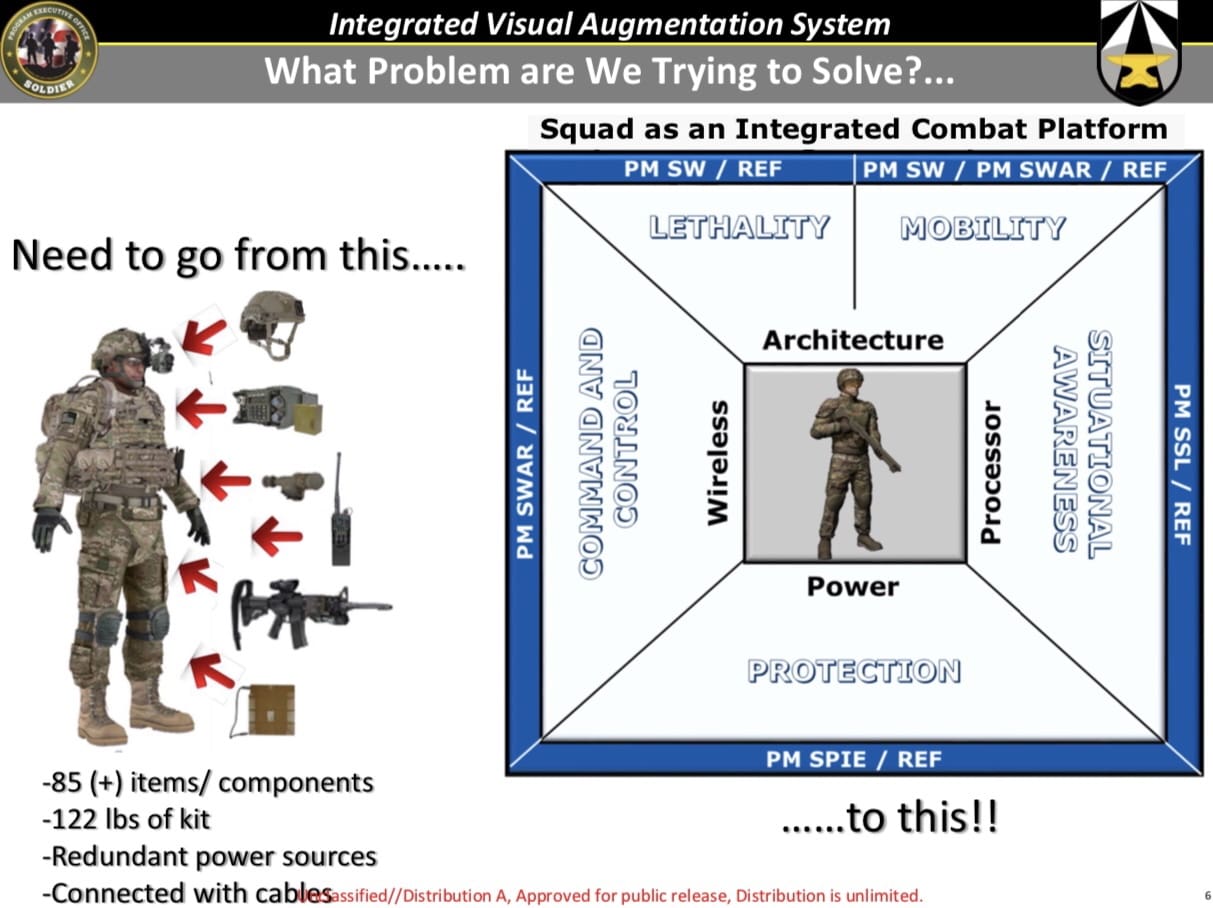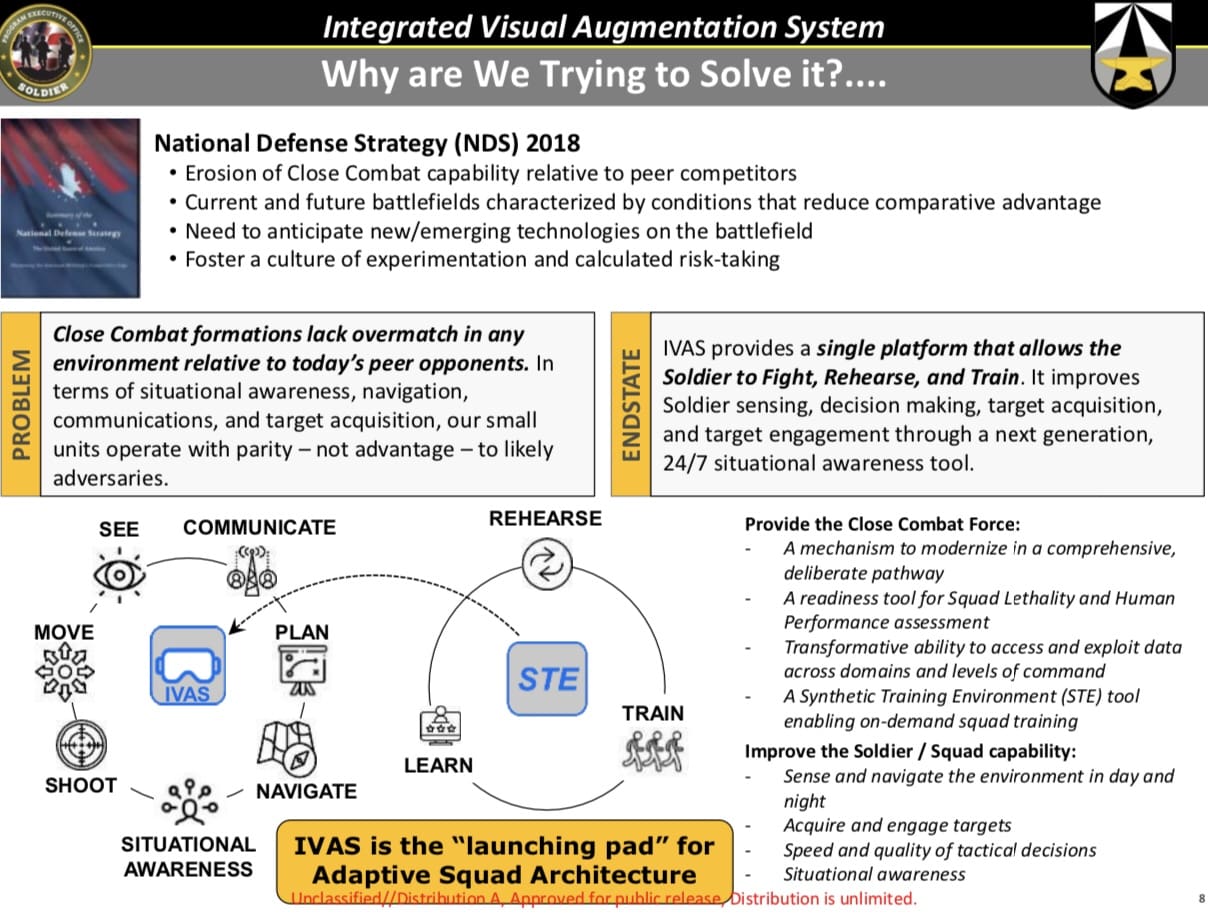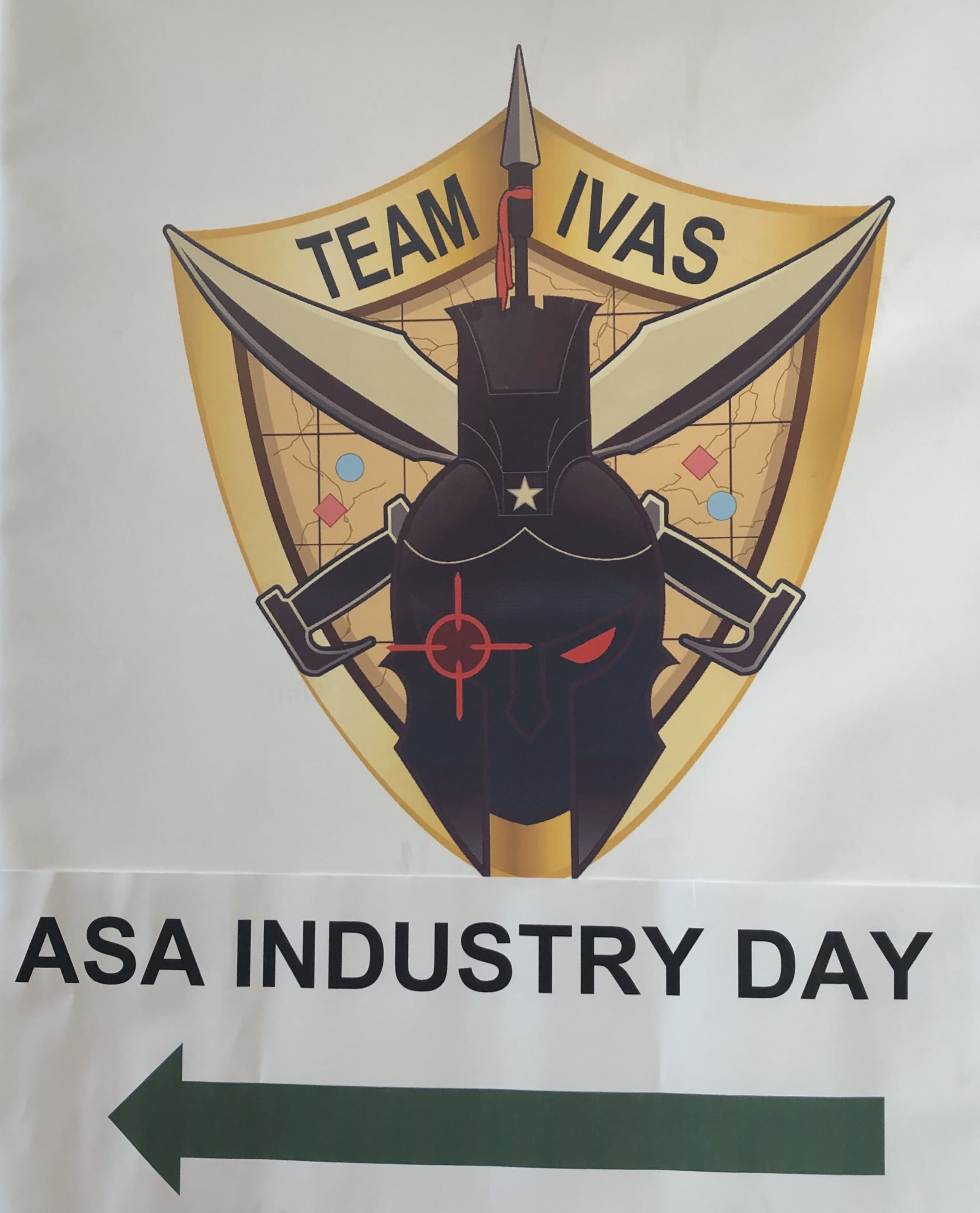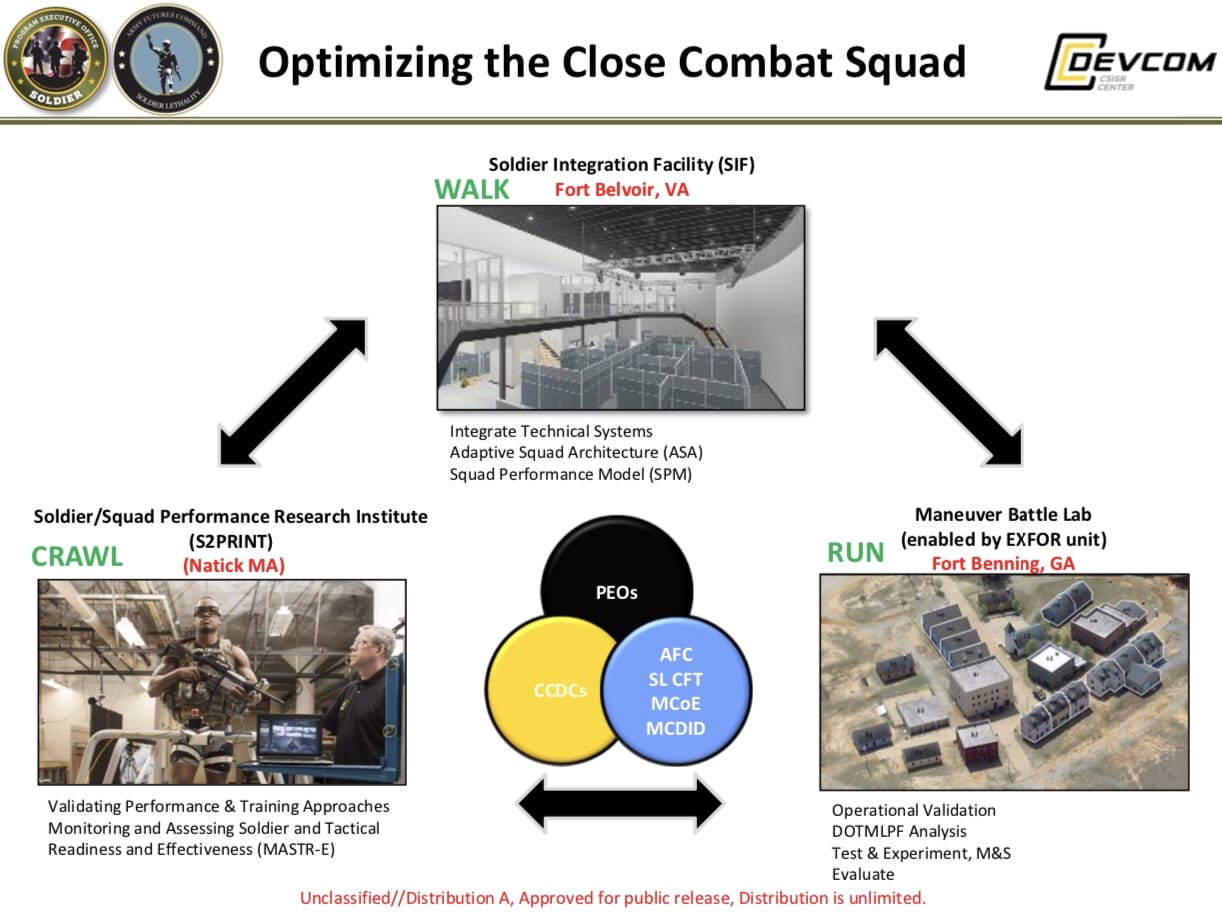For too long, the Army has treated the Soldier like a Christmas tree, hanging pieces of equipment here and there. In total, it consists of 85 pieces of kit, weighing 122lbs with some of the burden owing to redundant power sources and connector cables. Adaptive Squad Architecture is going to change all of that.

To do this, the Army is preparing to undergo an 18-month effort to use a Modular Open Systems Approach (MOSA) to create system-level Interface Control Documents (ICD) for the Adaptive Squad Architecture.
The Catalyst For Change
The catalyst for this transformation is the development of the Integrated Visual Augmentation System by Microsoft, a single system which allows the Soldier to Fight, Rehearse and Train. It integrates I2 with thermal IR cameras, overlaid with augmented reality information. Artificial environments and adversaries can be fed into the IVAS screen allowing for training and rehearsal. Machine learning and Artificial Intelligence will offer a more dynamic foe who learns from the Soldier’s actions, like a real enemy.

It is such a leap ahead, a whole architecture had to be developed along with it, including comms links and power. The Army concluded it was time to look at not just the Soldier, but the Squad as a whole.
The goal is to begin using the ASA by January 2021 as the foundation for achieving the Soldier as an Integrated Weapons Platform and the Squad as an Integrated Combat Platform making them a peer with other major weapon systems. To get there, they’re going to need standards for industry.
Interfaces
Key focus areas of the ASA will be establishing common standards and Interface Control Documents for power management; data management (on each Soldier, between Soldiers in the Squad, and between Squads); physical equipment interfaces; and size, space, and weight management at the Soldier and Squad level. ICDs will be living documents, adapting as technology improves.
Although, this article is primarily focused on the development of ICDs, ASA will also offer an Architecture Assessment Tool (AAT) and a Configuration Management (CM) Database which looks at the Soldier and Squad’s configuration and includes a visualization tool. The AAT allows the small unit leader to configure a Soldier and Squad, alerting to incompatible equipment choices and load weight concerns.
The MOSA approach is also intended to reduce the weight carried by Soldiers/Squads by having an architecture that facilitates combining multiple capabilities into a single hardware device and eliminating legacy hardware by developing software applications that can be used on existing peripherals.
Problem Solving
Adaptive Squad Architecture may be the most important undertaking PEO Soldier has ever performed. The very fact that PEO Soldier invited the media to attend their Industry Day is indicative of this fact. The last Industry Day we were invited to by PEO Soldier was the Camouflage Improvement Effort In 2009.

The name is exciting, but the work will be tedious, for government and industry alike. They plan to create system-level ICDs for a government-owned technical architecture for the Soldier as an Integrated Weapons Platform and the Squad as an Integrated Combat Platform. The goal is to make the Soldier and Squad into digital platforms. I look at ASA as akin to a Software Development Kit for the Soldier.
Primary stakeholders for the ASA are the acquisition community which directly supports the Soldier and Squad, namely the Science and Technology (S&T) partners, the combat developers, the materiel developers, and industry partners.
Although many of the Program Executive Offices across the Army will contribute to this effort, the program is under the watchful eye of PEO Soldier, BG Anthony Potts. Yesterday, he addressed a crowd consisting of government and industry professionals to layout the effort.
His biggest concern is that the ICD is meaningful to industry. He believes that the Army will initially get it wrong, but is prepared to work with industry to get it right. Communication is key. He also wants to energize better relationships with smaller, non-traditional entrepreneurs who have interesting, innovative solutions, without having to go through larger companies.
General Potts wants to focus on problem statements rather than solutions. This will allow industry to design and build, loosely coupled, highly cohesive, severable modules. Another important goal is to reduce proprietary designs. The Army will establish the interfaces, the ability to plug-in and plug-out (electrical, mechanical interfaces), but its up to industry to come up with the actual capabilities.
Earlier, I mentioned the Christmas tree analogy. General Potts used this example. The Soldier is burdened by a bunch of heavy ornaments like a Christmas tree. The call comes to reduce weight and make the Soldier more maneuverable, more lethal. That increased maneuverability means that a Soldier can draw and fire his weapon first. Potts comes to his conclusion, “He who draws first, generally wins.”
Soldier Integration Facility
One of the primary ways the Army is dealing with this new way of looking at the Squad is the creation of a Soldier Integration Facility on Fort Belvoir as part of the Close Combat Force Enterprise. The SIF will operationalize technologies. COL Troy Denomy will be in charge of the SIF, referring to it as a collaboration tool even though it’s a facility. It should open 1 October and will become pivotal for every PM shop at PEO Soldier as well representatives from others.
But even before the SIF gets their hands on it, a new concept begins at the Soldier/Squad Performance Research Institute (S2PRINT) at Natick and are then refined at the SIF. Once they’ve come up with a solution, they’ll work closely with the experimental force at the Maneuver Battle Lab to prove it out.

PEO Soldier plans to be their own integrator, including coders on the team. The SIF will also include a business office to work with industry. General Potts envisions this office will help smaller companies work with larger companies, write awards, or purchase IP outright. They hope to set aside $1 million to get this effort moving. They’ll leverage OTAs, BAAs and other collaborative acquisition tools to invigorate solutions.
Down In The Weeds
“Obviously, a big challenge is power,” General Potts related, “there are too many batteries.” He discussed the upcoming Next Generation Weapons. They will power themselves with a powered rail which also moves data and the rail will run all of the electronic enablers on the weapon.
Another issue is the proliferation of communications devices. Currently, only three Soldiers per Squad have a radio. As IVAS is fielded, every Soldier in a Squad will have a data radio with IVAS. Moving from 128 bit to 256 bit encryption Secure Ultra Wide Band to move data around the Squad in a secure, but unclassified network. The end user device will be replaced by a “puck” but it will still rely on ATAK as the software environment.
This led the discussion to software management. The Army plans for a single ATAK software update per year across the enterprise, vice the four SOCOM currently accomplishes, but that decision is a function of organizational size.
In one of the boldest moves, they’re setting up a marketplace for apps to allow Soldiers to customize their software load based upon mission. The vision is that it works in a similar fashion to a phone app stores like iTunes. This concept will reward developers based upon actual use rather than the current model which creates software which may or may not be used. Under the developmental name Watchtower, the marketplace is in beta testing with an initial roll out in Q1 20 and FOC Q4 20.
More To Come
After he wrapped up with industry, General Potts and his team spent a few monitored with the media. He related that the creation of the SIF isn’t the only organizational change coming to PEO Soldier. We’ll see some renaming of the Program Manager shops to better describe their roles and additional capabilities will be added to the team once a full mission analysis is completed.


This is looking a lot like a 21st century Land/Nett warrior. Too many different systems/items with too many fundamental problems ( i.e. weight/power/not yet existing tech) to see a real, useful roll-out.
I wonder if the Taliban, ISIS, Fatah, Al Qaeda, and Abu Sayyaf, all of whom have fought with various degrees of success the US Military to a standstill for 18 years now, have a group in some cave somewhere preparing PowerPoint slides on the next ephemeral fad that has piqued the interest of some of there cognitively challenged leadership? Perhaps, instead they are focusing on how to more efficiently to kill Americans with tools at their current disposal instead of developing new complex organizational charts on how they should be organized–about as useful as rearranging the deck chairs on the Titanic.
Our lack of ultimate victory has everything to do with national will and zero to do with our ability to destroy entire nation-states.
Amen, Well said!
I’d say it’s less national will and more a lack of any ultimate goal by leadership. You can’t have ultimate victory if you never decided what that should look like.
I think Jack points to the timeless truth that necessity is the mother of invention. Our less well equipped foes will always demonstrate remarkable resourcefulness and ingenuity when fighting us.
Our failure has little to do with national will. As I recall, the day after 911 and in the months and even years that followed, we had plenty of national will.
It seemed to me that we once had a clear strategic objective of developing a stable, unified Afghanistan that would no longer be a breeding ground for terrorism. I think we all see now that this was unrealistic – we seriously overestimated the desire and ability of the Afghans to bring that about (only they could do it), and we seriously underestimated the desire and will of other actors to prevent that from happening.
After 18 years, it’s time to go. I do feel bad for the women though.
We haven’t had national will since we dropped two atomic bombs on our enemies.
We had the National Will to avenge 9/11 and eliminate the ability of the Taliban and AQ to operate freely in Afghanistan. But we didn’t have the National Will to end the threat once and for all by eliminating their support bases in Pakistan, and we didn’t have the National Will to take the necessary steps to prevent the Taliban and AQ from escaping across the border into safe havens in Pakistan.
The we allowed Mission Creep to set in under the misguided notion of “Nation Building”, and by diverting attention and resources to Iraq….
“The average Roman is more concerned with the pebble in his sandal than where the Legion is fighting and why.” -Thuccides (I think..)
American “National Will” has a half-life of 15 minutes.
Sometimes it is just a low tech solution that is best after all for our combat soldiers. Lower the weights of combat soldier to actually maneuver again would give us the best solution. We are relying on high tech solution way too much I think. When the enemy can jam and hack electronic systems at will and just as well as us there will be problems at the squad level. Only training on basic skills of combat maneuver and low tech solutions that have been used years ago will provide real solutions.
A “low tech solution” will never be the solution in and of itself. If you intend to keep up with rival entities militarily, you must discard the notion that “basic training” will solve the pre-eminent issues. A soldier with a rifle and a pack is not going to win against an enemy that can kill him without even being in line-of-sight or within range of his rifle.
“When the enemy can…”. That’s the trick isn’t it? They can’t as of yet, and as long as we keep developing those tools, they likely never will. The US isn’t losing militarily against enemies with worse equipment. The entire problem is due to a lack of willingness to get to the root of the problem (i.e. implicit Pakistani support of Taliban/AQ). Does that mean we should invade Pakistan? No, but if we, say, cut off the roughly $800 million in annual aid we send them, maybe they’ll change their tune.
https://explorer.usaid.gov/cd/PAK
I guess you failed to understand what most infantry soldiers really need is to lighten their combat loads. As former infantryman, you can not maneuver with 122 lbs of equipment that you have carry. Technology will only get you so far on the battlefield. When your technology has been hacked, gps and communications jammed nothing will get our soldiers to win a war without the knowledge of what they have used in combat all the way back to WWII. Out maneuver the enemy and use what you have at hand. Our technology will not always be useful by our soldiers fighting near peer enemies. We need to always be able to fall back on what the infantry always have done. Field artillery is learning once again how to plot fire missions manually because of near peer enemies ability to jam our technology. Old school low tech ways are back and our soldiers must be able to use high tech and low tech solutions on the battlefield to win.
So every development beyond picking up a blunt stick is a waste?
Or a thigh bone…
https://www.syfy.com/sites/syfy/files/styles/1200×680/public/2001-a-space-odyssey.jpg
You’ve obviously seen my t-shirt. That is what I was thinking.
Glad to see our tax dollars being well-spent.
A reminder that the average infantryman could be way lighter than he is today if the Army had adopted good COTS items 10 years ago. This is gonna end as well as future soldier did. Good idea fairy bit hard with this one. The shit necessary to make “every soldier a sensor” still isn’t out, and they were pimping this stuff nearly 20 years ago. What makes you think it’ll be different this time?
Remember that COTS items are designed for casual life between taxi and openspace, not for dirt, rain and wind. There is a reason why DoD navigator is able to break enemy skull.
The really straight way for “Nett warrior” are open (non-proprietary) standards and versatile architecture, but big corporations do not want this.
Definitely took me back to the days of land warrior and FCS.
They said a lot in that technical talk (treating the squad as a weapon system, increasing commo/situational awareness, simulation/rehearsal/training capability, providing small unit leaders the ability to tailor themselves to the mission, common power solution).
The first is huge because the grunt has traditionally been shortchanged when it comes to investing. Planes, tanks, ships are sexier and involve more congressional districts spreading the dollars and getting politicians on board. About time we look at the squad holistically across the board vs. just how we arm him (and now her).
Don’t see how increasing commo capability, common power solutions and enabling simulation/rehearsal/training capability lowers weight. That is very FCS.
What they didn’t say is how this practically comes together. E.G. How do we integrate the next squad rifle into this initiative?
I read a lot about letting industry loose and circumventing the old acquisition model. That could be great stuff but all of this remains to be seen and as I said before sounds a lot like FCS that set goals way beyond current technology.
PS LOVE the idea of giving small unit leaders authority to tailor their units for the mission but don’t see their leaders giving them the freedom.
Goggles that obscure both eyes with VR augmented reality. You can do that now with a phone and overlay the VR. Can I just have my eyes to see the reality in front of me and my ears to hear my surroundings instead of constant bs chatter on the radios. Information overload.
PEO Soldier should focus on operationalizing industry to meet warfighter capability gaps as opposed to the current ever expanding model where the Army MCOE (CDID, ARCIC, etc), PEO, and NSRDEC have sought to replace industries capabilities with there own. Turning a once thriving industrial base in the shell of it former self, and a glorified chop shop. Not only will the Army not communicate it’s Soldier requirement at public events including industry days in fear of running afoul of a supposed iron curtain which might give one company and advantage over another for merely asking the right questions. BUT the same Army offices will under cut industry with government owned designs based on requirements not available to industry. This is exactly how you kill an industry. Next the Army will be looking to replace our production capabilities with there own. Once the Army decided they would enter the market as a player instead of a program manager, all of our death certificates were signed. It’s only a matter of time. In the future this will become an example of how not to manage Soldier requirements.